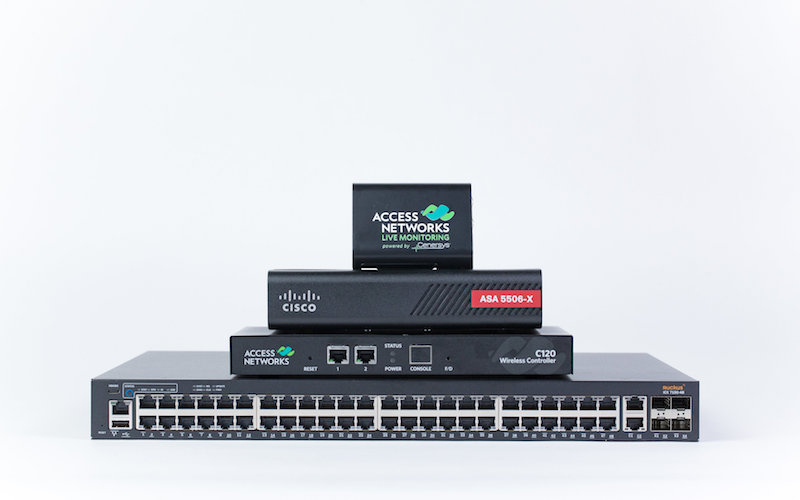Today’s Bandwidth-Hungry Smart Homes Require Networks That Can Keep Up
50 billion. That’s the number of internet-connected devices that we will be using by 2020 in our offices, vehicles, and our homes.
Nearly every device in our lives today can either communicate with other devices, store data in the cloud, automate a process, or permit us to communicate with each other in new and exciting ways. (Video over IP, anyone?)
Increasing Network Demands Require Robust and Reliable Networks
As the number of smart devices in our homes grows to rival or even surpass the quantity used in enterprise-level organizations, our network requirements increase proportionately. Wi-Fi and Local Area Networks (LANs) in home environments have needed to become substantially more robust in a very short period of time.
Choosing a network solution not engineered for today’s increased requirements can lead to a negative technology experience — and that will reflect poorly on the integrator’s bottom line and, potentially, their reputation.
Rolling a truck is costly, and customers don’t want to hear that their network won’t be back up for a couple of hours, much less another day or two. Today’s homeowners, especially those who have invested in luxury custom installations, expect 100 percent uptime from their network and the home technology systems connected to it.
Learning from Large Enterprises
Large businesses have had these needs and expectations for years and now, enterprise-grade systems easily meet today’s demands for robust, reliable, scalable, and secure residential networks that can be remotely monitored and managed to help provide an outstanding technology experience to the users.
Home technology professionals can take a page from the book of commercial systems integrators in providing an enterprise-grade network deployment for virtually every project.
Best practices for enterprise-grade networks entail designing a system that can evolve and grow with the client’s needs and incorporates hardware that provides the tools necessary for enterprise level support. Having the ability to easily troubleshoot anomalies, modify the configuration through software or install more product and/or better products to meet increasing demands ensures superior network performance. Today’s home integrators who follow these best practices and are willing to upgrade and service their customers’ networking systems as required will create satisfied customers for years.
Meeting Wi-Fi Requirements in Larger Homes
Wi-Fi is a significant component of today’s networking requirements and a great example of why enterprise-grade networks are crucial in today’s luxury homes.
Most older homes designed in the 1950s and 1960s measure smaller than 2,000 square feet. This represents many dwellings in use or on the market today. Most home networking devices are designed for homes within that bell curve.
But any home larger than about 2,000-square-feet will require multiple Wi-Fi access points. This encompasses a significant portion of the houses that hire custom integrators to design and install smart home technology, including control systems, security, distributed audio, and home theaters or media rooms.
Enterprise-grade systems are designed with multiple access points and are also easily expandable to meet the needs of hundreds of users across hundreds of thousands of square feet. Consumer Wi-Fi devices can be overwhelmed by users attempting to join a Wi-Fi network during parties or small gatherings which can prevent a home owner from being able to interact with their home. Many luxury homeowners want Wi-Fi capabilities pool-side, in their front yard, in garden areas, and even as far as adjacent land they might own and they want to ensure that the Wi-Fi will perform flawlessly at all times, not just when they are home alone. Only a properly designed and deployed enterprise-grade Wi-Fi network solution can support these requirements.
Defining Enterprise-Grade Network Requirements
Wi-Fi capabilities are just the beginning when it comes to luxury home networking requirements. Just as critical is the ability to communicate with and control devices on the hard-wired LAN.
Many manufacturers boast that they sell enterprise-grade products. But, even if the products they sell are durable enough to be considered enterprise-grade, it doesn’t mean they meet the requirements of an enterprise-grade network deployment.
Businesses require a network that is scalable, 100 percent rock-solid reliable with zero downtime, and secure. To fulfill these requirements, an enterprise-grade system must have enterprise-grade hardware, enterprise-grade programming, and enterprise-grade support. If any of these are lacking, then it is not a true enterprise-grade solution.
Before choosing components for your next custom integration project, find out whether the networking system you are considering is genuinely enterprise-grade, with the support you need behind it.
The Difference in Enterprise-grade Hardware for Smart Home Projects
Many enterprise-grade products use more robust components and power supplies, some with lifespans of 10 to 30 years. This means your client’s network is less likely to go down due to a power supply failure or any other hardware-related issue.
Consumer- or Prosumer-grade networking systems are designed to be easy to program, with a simple web GUI which will only provide a limited set of features and tools. They sacrifice capabilities in exchange for this ease-of-use. Enterprise-grade hardware gives systems integrators deep visibility into the network and the tools to troubleshoot issues, locate any problems, and then solve them, remotely or on-site, through programming or network design changes.
Finally, enterprise-grade hardware higher levels of security requirements. As the amount of data home users store on their network increases and we become more reliant on the network for functions from sprinklers and shades to door locks and security cameras, enterprise-grade security in routers, switches, and access points is absolutely critical.
How Enterprise-Grade Software Provides Scalability
Enterprise-grade programming means that engineers have followed best practices for commercial IT networks to ensure a highly scalable, highly stable network. If you don’t use best practices during your network installation – or hire a firm who deploys networks using best practices – a simple network change can lead to catastrophic failure.
On the other hand, programming that follows best practices makes it easy to scale the network as requirements grow and new devices are added to the home. Combining enterprise-grade hardware with enterprise-grade programming makes it easy to scale the network without replacing components.
Enterprise-Grade Service Makes the Difference in Today’s Smart Homes
Proper hardware selection and the associated programming along with the application of best practices is still only the beginning when it comes to providing an enterprise-grade network solution. Enterprise-grade hardware enables a greater level of visibility into the network and provides a higher level of performance, especially when properly programmed and configured, but you aren’t providing your clients with a full-fledged enterprise-grade solution without the service to match.
A well-functioning network should be virtually invisible. Your clients won’t notice it, because they can turn on any device and it just works. Remote monitoring and management capabilities allow integrators to be proactive with service and support while reducing truck rolls and service costs. Enterprise grade network solutions improve this support model by providing additional levels of monitoring and more robust tools to use when remotely diagnosing an issue.
For instance, a customer may not realize the network is lagging because the hardware offers enough bandwidth to support increased demands, but the integrator or his service team may be notified about a change in performance through a remote monitoring service or software. The integrator can resolve the issue before it becomes catastrophic to the network – and before the client even notices.
Ultimately, an enterprise-grade network is only as good as the hardware used and the team supporting it. Simply installing more expensive hardware does not mean that a client will have a better experience. Technology integrators would be wise to consider whether their network solution is truly enterprise-grade and if it offers the service and support the project requires –and their clients expect.








